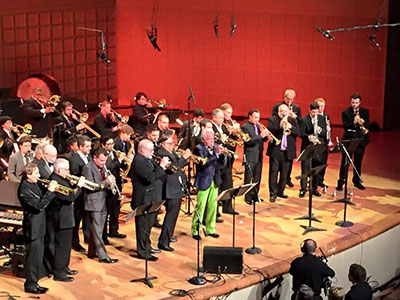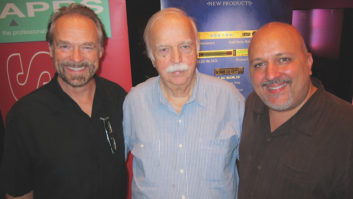
Sanken 100K Microphones Play Vital Role in Orchestral Masterpieces
Pictured is the “Cancer Blows” benefit concert featuring Doc Severinson. Five Sanken CO-100K microphones are visible above the musicians on stage.
Michael Bishop, 2015 GRAMMY(c)-winner for Best Engineered Album, Classical, also recently captured the orchestral excellence of the “Cancer Blows” benefit concert with his Sanken CO-100K microphones.
“The common element in both of these historic projects was the Sanken CO-100K’s across the front of the orchestra,” explained Bishop. “That is where the main part of the whole soundscape is captured. In the middle, there is a left-center-right setup with the 100K’s, and then two flanking microphones, and that has to be right first before anything else is added in.”
Bishop won his tenth GRAMMY(r) this year for his recording of “Vaughan Williams: Dona Nobis Pacem; Symphony No. 4; The Lark Ascending,” with Robert Spano conducting the Atlanta Symphony Orchestra and Chorus, recorded at the Woodruff Performing Arts Center in Atlanta, Georgia.
“Basically, we used the performance space as an extremely large recording studio,” explains Bishop. “And we set up our control room in the music library. We brought in full acoustic treatment and monitored in 5.1 with an ATC SCM150 5.1 monitoring system. The conductor can come in and hear it the way that he just heard it out on stage, and it makes it very easy for us to work on the performances and the sound.”
Bishop’s Sanken CO-100K microphones are unique, the world’s first designed for recording music up to 100kHz. “They are the perfect match for the formats in which I record,” explains Bishop. “It’s Direct Stream Digital, which is sampled at rates up to 11.2 MHz, and has frequency response out beyond 100K, and a high resolution PCM recording, again with frequency response well out beyond the range of human hearing.”
He continues, “The reason we want to have the front end of our recording system be that wide bandwidth is that when you start rolling off high-end, that roll-off actually extends down into the range of human hearing. You want to push any anomalies of frequency response, filtering, or whatever, out well beyond the range of human hearing so that where we can hear, all the harmonics remain intact, and all of the information is flat well out beyond 20K. Even though we can’t really hear it, it is something that you sense.”
Pictured is Michael Bishop adjusting a Sanken CO-100K microphone.
The “Cancer Blows” Dallas benefit concert featured legendary trumpet players including Doc Severinsen, Arturo Sandoval, Lee Loughnane (the band Chicago) and Canadian Brass alumni Ronnie Romm, Ryan Anthony, Jens Lindenmann and Joe Burgstaller, joined by members of the Dallas Symphony Orchestra conducted by Jeff Tyzik and Robert Moody and the UNT One O’Clock Lab Band in a once-in-a-lifetime musical event at the Morton H. Meyerson Symphony Center.
Bishop describes his orchestral microphone technique when there is a prevalence of brass instruments. “Again, I had the five Sanken CO-100K’s across the front; that was my main pickup. That’s where the overall bloom and picture came from; in particular, on the classical and on the softer ballad-like pieces, that’s where the real beauty was. I needed Royer ribbon mics to zero in on various soloists for the mix to video where I wanted to emphasize more closely the solo artist and make it sound like a close-up. For the audio-only program for CD, I’ll depend more on the main microphones for the overall sound.”
Michael Bishop, whose engineering credentials are impeccable, sums it up and gives credit to the musicians above all. “You’ve heard it from a lot of other engineers, and every one will tell you that it’s these great musicians that make us engineers look good. As long as I’m conveying their intention, the recording is successful. That’s how I felt about the GRAMMY-winning Atlanta session. At the time the music was going down, I had that feeling that I’ve had only a few times in the past — this one is really something special, there’s really something going on with this performance, the recording gods are smiling on us. Everything’s lined up.”
Learn more about Michael Bishop and his Five/Four Productions:
http://www.fivefourproductions.com/
Learn more about “Cancer Blows” at: http://www.cancerblows.com/
Learn more about Sanken at: http://www.sankenstudio.com/







